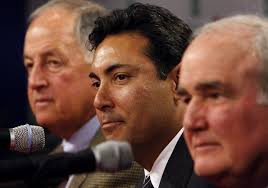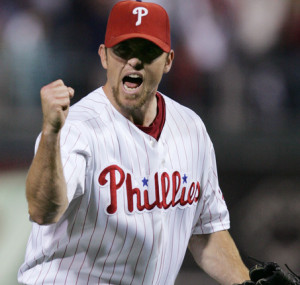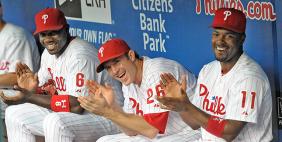History tells us the team wins when money is spent.
By Joe Darrah
Disclaimer: When reading this column keep in mind that the Phillies received a $2.5 billion TV deal in early 2014. $2.5 billion.
The enchanted version of the Phillies path to the 2008 World Series holds that the organization won it all mostly by building from within and learning how to win with younger players as opposed to spending money on the market. Herein lies the framework for the fallacy believed by many that the best way for this organization to work towards another championship is to tighten its purse straps, avoid deep-pocketed free agent acquisitions (particularly as it pertains to “older” players), dump all of its existing older players and “rebuild” its Major League roster with prospects.

If these guys are being asked “Should you all be spending more money?” the easy, resounding answer should be “yes.” Photo credit – NJ.com
But that belief is, at best, an outright fairy tale better suited for a small-market club in a town where multibillion-dollar TV deals are just as imaginary. Truth be told, the best chance for the Phillies to return to the form of annual championship contention will occur if and when they decided to “rebuy” as a means of retooling.
Don’t be fooled by your own memories: The Phillies bought and traded away young prospects in building the squad that won its most recent World Series championship just as much as it did develop it through the farm.
Nobody exemplifies this reality more than former closer Brad Lidge, who was acquired just after the 2007 season, a season in which he had been stripped of his closing responsibilities in Houston, which was due to ineffectiveness more than anything else, for three minor leaguers: outfielder Michael Bourn, pitcher Geoff Geary, and third baseman Mike Costanzo, a Philadelphia-area native. Bourn would go on to be a two-time All Star, lead the league in steals three times and earn a pair of Gold Gloves—all of which would be moot for the Fightins.
As if trading away three promising prospects wasn’t enough to prove the value then general manager Pat Gillick saw in an often-injured 31-year-old one-time All Star, it took fewer than four months (and fewer than 20 saves in a Phillie uniform) for Gillick to extend Lidge with a three-year $37.5 million extension, which still ranks as the third highest per-year deal for a reliever (oddly enough tied with current Phillie closer Jonathan Papelbon at $12.5 million, according to Baseball Prospectus). Gillick made that deal despite Lidge’s checkered reputation to that point — namely for his numerous injuries that kept him off the field as well as his sketchy performance in the 2005 postseason.
Of course, the trade for and retaining of Lidge turned out to be an incredibly beneficial strategy as he would eventually be named to his second All Star team, would convert all 41 of his save opportunities in the regular season and follow up in the playoffs by securing each of his seven save chances. Likewise, the trading for former starter Joe Blanton late that July (for three more prospects) further exemplifies how relying on and spending money on experienced veterans versus the hope of prospects can be all the difference in winning a World Series and not.

The Phillies paid big for Brad Lidge, and he was worth every penny. It stands to reason why spending big on Jonathan Papelbon as well made sense. Photo credit – LehighValleyLive.com
You simply do not win in 2008 without Lidge. It’s debatable whether or not you still win without Blanton, who to his credit went 6-0 after being traded (including postseason) after being a woeful 5-12 with a 4.96 ERA with Oakland that season. What’s not debatable is that the prospects given up amounted to nothing of significance to warrant any agenda to try to win with prospects today. Big market teams should spend like big market teams because that’s the easiest way to stay competitive most years. Just ask the Yankees. Relying mostly on one’s own farm or jettisoning aging players for the acquisitioning of young, inexpensive talent to produce a championship roster is far less likely to be effective. Just ask the Atlanta Braves of the 1990s, who managed just one championship despite 13 consecutive division crowns by employing a vast majority of their own prospects, or the Kansas City Royals, whose “rebuild” took only 19 years to make the postseason after winning in 1985.
It’s also not coincidence that as the Phillies continued to spend money in free agency and ship out prospects through 2011 that they continued to win more games, culminating in the most wins in franchise history in 2011. Obviously, the lack of a second championship left something to be desired, but you tend to have a better chance of winning the World Series when you make the playoffs. And the Phillies lack of playoff participation as of late directly coincides with the trend of not being aggressive financially.
Even relying on older and/or free agent players such as Jamie Moyer, Jayson Werth, Chad Durbin and Scott Eyre was crucial to the 2008 title team. Of course the homegrown nucleus of Ryan Howard, Chase Utley, Jimmy Rollins, Cole Hamels, Pat Burrell, Carlos Ruiz, Ryan Madson, Brett Myers and, yes, even Kyle Kendrick collectively played a big part in not just that championship campaign but the run that saw the Phillies as one of the league’s most dominant teams for the better part of five consecutive years. It’s very fair to say that they could not have won without any from this group, as well as the likes of Shane Victorino, who was “sort of” a farm guy. Heck, it could even be said that players like Geoff Jenkins, who essentially cost the Phillies $13 million for one key postseason hit, and Matt Stairs, yet another veteran who cost a prospect, were essential in 2008. The lesson here, folks, is that no team is good enough to think that it can safely stop spending or distance itself from the marketplace. And youth does not a roster make better. It’s not like the 2008 roster was a bunch of young studs missing one or two crucial pieces. As a matter of fact, the team wasn’t even “young.” The average age of the 2007 squad (89 wins) that cracked the postseason drought, only to be swept — 28.8 years. After the improvements made for and during 2008 (92 wins) the average age climbed to 32.3 years, which is actually older than was the average age of the 2014 roster (30.5) that so many people claim was “too old.”
Yes, it’s true that the roster in 2008 may have been more inexpensively put together than it is now, but that’s merely a matter of circumstance as the “core of the core,” namely Rollins, Howard and Utley, were due to become free agents near each other and the price of MLB contracts overall for accomplished players only continues to rise. Besides, it’s not like the 2008 team came “cheaply” among its veterans. Burrell cost $14 million for 2008 alone. Moyer was paid more than $12 million for 2008-09. Anyone under the delusion that current GM Ruben Amaro is the only human being alive who would have paid the likes of Howard, Utley and Rollins large sums of money need look no further than Gillick’s (and predecessor Ed Wade’s) aforementioned stipends as well as the money committed to far less accomplished players such as Adam Eaton (by Gillick), who cost more than $16 million for 2008-09, and Freddy Garcia (again by Gillick), who “earned” $10 million in 2007 for going 1-5 with a 5.90 ERA in 11 starts and cost the Phillies two prospects who have actually had success in the majors in Gavin Floyd and Gio Gonzalez via Gillick’s trade with the White Sox in December 2006.

With the way baseball contract prices are headed, it won’t be long until the signings of Howard, Utley and Rollins seem “cheap.” Photo credit – USAToday.
Looking at each Phillies team through 2011 each one of them needed the services of sometimes costly and sometimes older (and sometimes both) players from the market in order to be as good as they were individually and collectively. Raul Ibanez, Cliff Lee, Roy Oswalt, Roy Halladay. The Phillies would not have won more games with each successive season through 2011 without spending money and/or giving up prospects for the likes of these players. In fact, it wasn’t until management began its quasi-rebuild and absolute downshift in free agent spending that the losses began to outnumber the wins.
Wouldn’t it be plausible to think that the 2013 squad could have done more with Torii Hunter or Nick Swisher instead of settling for Delmon Young out of the bargain bin? Or that the 2014 unit could have remained in contention longer with the help of a Phil Hughes or Tim Hudson or Scott Kazmir as opposed to signing Fausto Carmona Roberto Hernandez? I do.
The trading away of Rollins to Los Angeles this offseason, a team that I might add had an average age of 30 last season, hasn’t won a championship since 1988 and whose most expensive player entering 2015 — a pitcher, I’m sure you know who he is — sports a 1-5 postseason record to go along with a 5.12 ERA, could eerily forecast a trend of the organization going back to its miserly ways (as if the trading away of Lee in December 2009 and Hunter Pence in July 2012 didn’t foreshadow this enough). There is no heir apparent to deservedly replace the four-time Gold Glover. Yet this trade seems to have overwhelming approval in this town. I just don’t get it.
The sheer existence of the Comcast deal makes it shameful that ownership would not continue to be aggressive financially each and every year. Philadelphia fans have put too much money into Citizens Bank Park to settle for anything less. So why would you? Why would so many of you want to see this team not spend money as a means to try to win now?
Be careful what you wish for, Philadelphia sports fans.
 Philly Sports Jabronis
Philly Sports Jabronis
